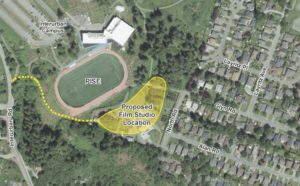Camosun College is working with Vancouver-based construction company Lexi Development Group to discuss the feasibility of building a film studio, sound stage, and related educational facilities at its Interurban campus. This could lead to new programs for students in film-specific trades such as carpentry, metalwork, hair and makeup, and 3D animation. These discussions are still in the early stages, but those involved are unanimously confident that it’s the right time for a fully operational film studio to emerge on the South Island.
Camosun vice president of partnerships Geoff Wilmshurst says that some of the educational programs that would use the studio would focus on fine-tuning the trades skills that are involved in film production.
“I think it’s going to be in a few different areas,” says Wilmshurst. “One will be really Continuing Education add-ons for trades, where there’s specific needs in the film industry for a trade, but with a particular kind of skill set.”

Aside from these trades skills, Wilmshurst says that another educational focus involving the new studio would be based around technology.
“3D animation and special effects, those kinds of jobs are in huge demand, and they require a very specific kind of training,” says Wilmshurst. “And while we have a great computer science set of programs at Camosun, we do need to develop something that would be specific to the industry.”
Saanich mayor Fred Haynes says that this is an opportunity to create jobs for creative professionals on Vancouver Island.
“It’s not just about economic development and education,” says Haynes. “It’s also about giving a whole range of new types of careers right here in the region—careers based on creative intelligence, script writing, the love of art, the love of being involved in creative digital media. The wardrobes, the hairdressing, it talks to all the creative side of our brains, as well as, of course, the engineering and the mathematical side.”
Camosun College Student Society (CCSS) external executive Fillette Umulisa says that the CCSS is excited about the potential for Camosun students to branch out.
“It’s a good opportunity for us and our students to have something that’s going to create more opportunities for students,” says Umulisa, “just diversifying areas in which students can study. The film industry is going to be one thing that brings more students to Camosun; it also helps the ones that are currently at Camosun diverge into different areas.”
Wilmshurst says that film productions on Vancouver Island often have to employ people from Vancouver or Los Angeles in order to equip their sets.
“Everyone that we’ve spoken to in the film industry just loves the idea,” says Wilmshurst, “because the big challenge is actually finding people who have the skill set to be able to work in film, especially in a place like Vancouver Island, where, typically, people are imported either from Vancouver or from LA to do film work. If they had a built-in set of workers it would make things much easier and much less expensive.”
According to Haynes, because there is not enough work on the island, many of those who work in film have to relocate in order to find a job.
“Many of our best talents have to go to Vancouver to apply their trade, or elsewhere,” says Haynes. “We have some of the great talents here on the island, but they can’t find local work.”
Haynes says that the average salary for professionals in film is high, and that this studio would allow young people to find a good career on Vancouver Island.
“The average salary is like $100,000,” says Haynes. “So when I talk about creative people being involved in wardrobe, artistry, and set design, they all get really good salaries. It’s this kind of economic expansion that would be wonderful to help retain our young people here that graduate from Camosun and other places. They don’t have to travel away if we can secure this.”
According to Wilmshurst, Camosun is on the radar of technology companies like Sony Pictures Imageworks, where the demand for skills like 3D animation is high.
“I’ve had conversations with Sony Imageworks, who are really keen to see some kind of a program developed at Camosun that would allow them to hire our students,” says Wilmshurst, “because they just have huge demands for 3D animation and other kinds of film work.”
Aside from the direct economic impact of this studio, Haynes says that there would be echo effects on industries such as transportation.
“People have to arrive on set really early,” says Haynes, “usually 6 to 7 am, and then they stay on set until midnight, so that means that the travel to work is off peak… So it actually adds extra ways of bringing forward economic renewal and diversity on the same road infrastructure but at off-peak times.”
According to Haynes, Victoria is already on the map for film producers seeking production locations.
“An exciting thing I’ve heard through the grapevine is that when the movie producers are looking at places to film now, there’s a label saying ‘Victoria studio coming,’” says Haynes. “So it’s clear that we’re getting the attention.”
